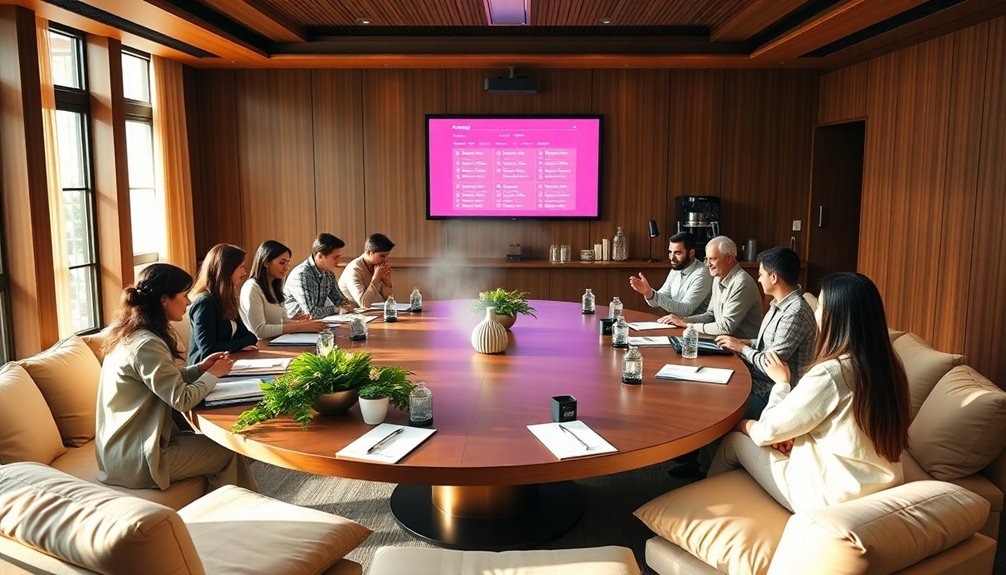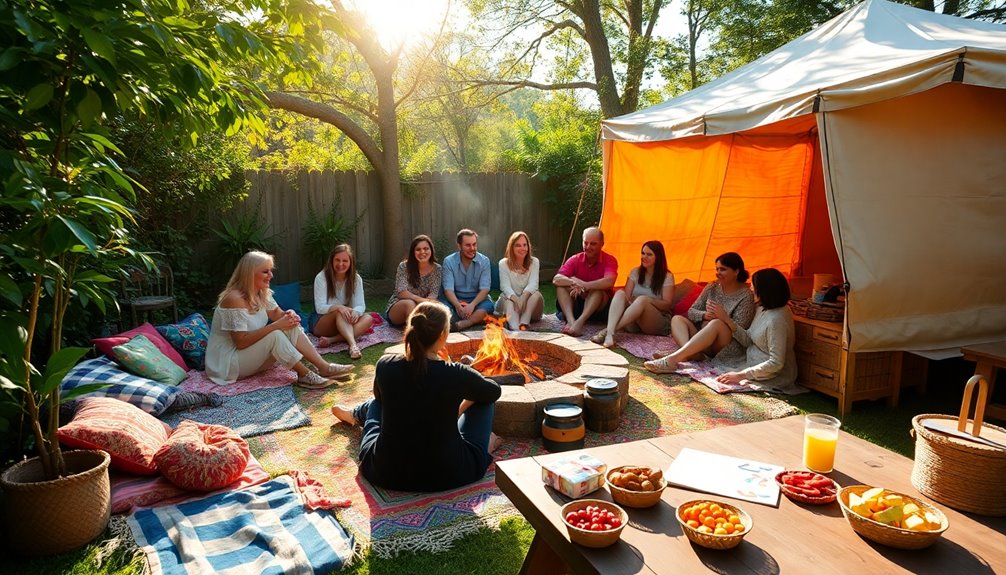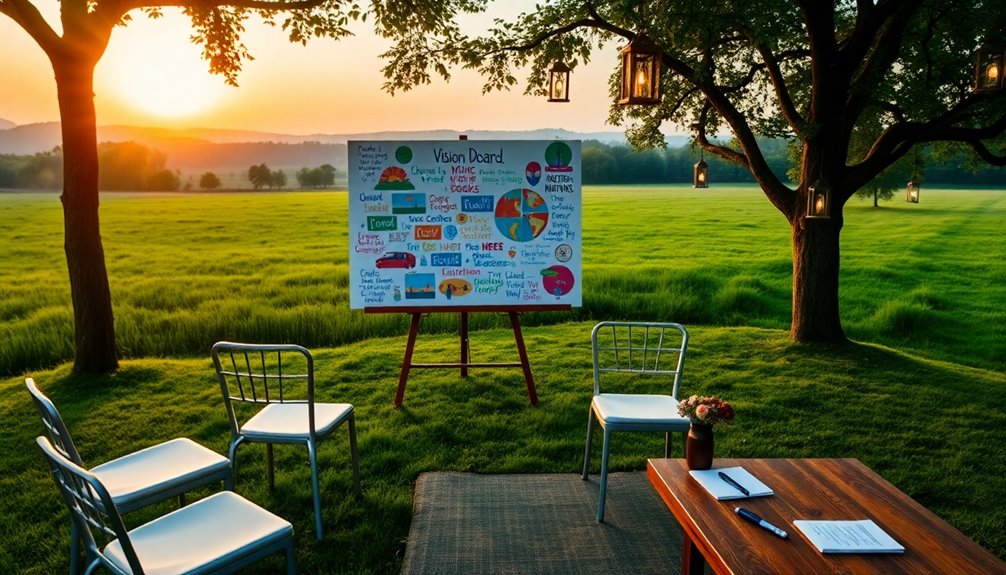To plan a retreat that everyone will be talking about, start by defining your vision and objectives. Assemble a skilled team to handle various roles, ensuring clear communication. Create a balanced itinerary that includes engaging activities and downtime for reflection. Incorporate icebreakers and team-building exercises to foster connections, while also considering the participants' needs. Before the retreat, conduct a pre-call to align everyone on the agenda. Lastly, set clear goals to measure success and follow up post-retreat to evaluate what worked. By focusing on these elements, you'll lay the groundwork for an unforgettable experience. There's more to discover!
Key Takeaways
- Set clear, achievable goals and a compelling vision to create a focused and engaging retreat experience.
- Incorporate diverse and interactive activities that foster teamwork, creativity, and open communication among participants.
- Choose a suitable venue that enhances the retreat atmosphere and ensures accessibility for all attendees.
- Provide ample downtime for reflection and relaxation, balancing work with personal growth opportunities.
- Gather feedback post-retreat to evaluate success and improve future events, keeping participants engaged long after the retreat ends.
Define Your Vision and Purpose

When you start planning a retreat, it's crucial to define your vision and purpose, as this foundation will guide every decision you make.
First, clarify the retreat's main objectives, considering what you want to achieve and the central theme. Understand your audience's needs to ensure they gain valuable insights. Many participants are increasingly seeking spiritual experiences that promote personal growth and mindfulness.
Set clear, SMART objectives that align with your vision, and prioritize them for focus. Develop a compelling vision statement that reflects your core values and highlights the benefits participants will experience.
Remember, it's about the transformations they'll undergo, not just the activities. Additionally, consider how your retreat can serve as a platform for collaborating among directors and teacher-leaders to enhance engagement and drive collective success.
Finally, create a cohesive agenda that fosters engagement and supports your goals. With a well-defined vision, you're on your way to a successful retreat.
Assemble a Skilled Team

A well-defined vision and purpose set the stage for your retreat, but executing that vision requires a skilled team. Start by defining clear roles: a team leader to oversee planning, an activity coordinator for scheduling, a logistics manager for venue and transport, a budget manager for financial tracking, and a communication officer for updates. Select team members with relevant skills, such as event planning experience and creative thinking. Ensure diversity in your team to bring various perspectives and cultural sensitivity.
Incorporating unique amenities can also enhance the overall experience and attract guests. Establish clear communication channels through regular meetings and task assignments, and foster teamwork with shared goals and team-building activities. This collaborative approach builds trust, ensuring everyone works together to create an unforgettable retreat experience. Incorporating team-building exercises as part of your activities can enhance collaboration and strengthen team dynamics.
Design a Balanced Itinerary

Designing a balanced itinerary is crucial for ensuring a fulfilling retreat experience, as it helps attendees engage meaningfully while also allowing time for relaxation.
Start by balancing activities and downtime—avoid overloading your schedule to maintain guest comfort. Consider the retreat's natural rhythm, weaving in reflection time for self-discovery. Incorporating natural elements like plants and comfortable seating can enhance the overall atmosphere of the retreat.
Focus on a few key activities that align with your retreat's goals, leaving ample time for rest or exploration. Empower guests with autonomy by offering optional activities, catering to different paces. It is essential to ensure that each experience reflects the core message of the retreat, enhancing its impact on participants.
Lean on local expertise for unique experiences relevant to the season, enhancing authenticity. Lastly, plan the details in advance to minimize decision fatigue and ensure a seamless experience, creating a sense of security and consistency throughout the retreat.
Conduct a Pre-Retreat Call

How can a pre-retreat call set the tone for a successful experience? This call's crucial for establishing clear objectives and introducing the facilitator, ensuring everyone knows what to expect.
Discuss the retreat's theme, goals, and agenda to align participant expectations. Clarify each person's role, emphasizing cooperation and responsiveness, which are vital for a productive retreat. This collaborative effort aligns with the goal of enhancing interpersonal communication skills among team members. Additionally, ensuring that participants understand the importance of customer satisfaction ratings can further promote a positive atmosphere.
Establish communication channels for questions or concerns, and provide preparation tips to help participants feel ready.
Make sure to outline logistics, including location, schedule, travel arrangements, and accommodations.
Select Engaging Activities

Selecting engaging activities is essential for fostering a vibrant atmosphere during your retreat. Start with icebreaker games like "Two Truths and One Lie" or "Charades" to warm up the group.
Next, consider creative classes such as mixology or a cooking class, which encourage collaboration and skill-building. Outdoor activities like water sports or a camping expedition can enhance bonding and teamwork. Additionally, planning activities that prioritize children's well-being can create a more inclusive environment for participants with families.
Interactive games, like "Escape Room" or "Shipwrecked," promote communication and problem-solving. Each activity should aim to energize participants while fostering connections. Incorporating team-building games can further strengthen relationships among participants by addressing challenges together.
Utilize a Planning Checklist

While planning a retreat can seem overwhelming, utilizing a well-structured checklist simplifies the process significantly. Start by choosing and confirming the retreat date, ensuring it works for everyone involved.
Next, determine the retreat's purpose, aligning it with your organization's objectives. A clear purpose can also help in creating a more organized environment, which is crucial for successful planning. Once you've defined your goals, estimate the budget to cover all expenses, including venue, transportation, and meals. Establishing a clear purpose is essential for guiding the overall planning process.
Identify and book the retreat venue, considering location and amenities. Compile a list of guests, gathering contact details and any special requirements they may have.
Finally, create a detailed itinerary that outlines the schedule of activities. By following this checklist, you'll keep everything organized and ensure a successful and memorable retreat for all participants.
Establish Clear Goals

Establishing clear goals is crucial for the success of your retreat, as it provides direction and purpose for all participants. Start by defining specific and measurable objectives that align with the retreat's purpose. Involve key stakeholders to ensure everyone's on the same page.
Breaking down large goals into smaller, actionable steps can be enhanced by using techniques that promote intrinsic motivation, making them time-bound and manageable to maintain momentum. Align these goals with the overarching theme of the retreat, ensuring they foster innovation or improve communication, as needed. Additionally, ensure your goals are realistic and achievable within the retreat timeframe, as this will help maintain focus and drive throughout the event.
Lastly, ensure your goals are meaningful and relevant, guiding teams with clear direction and motivation. Avoid vague targets that lead to confusion, and celebrate achievements to keep spirits high throughout the retreat.
Frequently Asked Questions
What Is the Ideal Location for a Retreat?
The ideal location for a retreat really depends on your goals.
If you want to inspire creativity, consider a nature-based setting with forests or mountains.
For relaxation, coastal spots with ocean views are perfect.
If adventure and team-building are on your agenda, mountain retreats offer thrilling activities.
Alternatively, rural and farm-based locations provide privacy and a chance to disconnect from daily life.
Choose a place that resonates with your group's needs and vibe.
How Do I Manage Dietary Restrictions for Attendees?
When it comes to managing dietary restrictions, think of it as crafting a delightful feast that everyone can enjoy.
Start by gathering dietary preferences during registration and follow up for specifics.
Collaborate with caterers to create a varied menu, ensuring clear labeling and separate preparation areas to avoid cross-contamination.
Train your staff on food handling and emergency protocols.
What Are Effective Marketing Strategies for Promoting My Retreat?
To effectively promote your retreat, leverage social media marketing by sharing engaging content and using targeted ads to reach your ideal audience.
Email marketing's key—send newsletters and exclusive offers to keep potential attendees informed.
Optimize your website for SEO, focusing on relevant keywords.
Content marketing can build emotional connections through story-driven posts.
Finally, encourage testimonials and reviews to establish credibility and attract new clients.
These strategies will elevate your retreat's visibility and appeal.
How Can I Measure the Success of the Retreat?
Did you know that companies with engaged employees can see a 21% increase in profitability?
To measure your retreat's success, start by establishing clear, measurable goals using the SMART framework.
After the event, gather feedback through surveys and direct discussions.
Look at performance metrics pre- and post-retreat, and analyze ROI by comparing costs against benefits gained.
Observing team dynamics and employee retention rates will also provide valuable insights into your retreat's impact.
What Should I Include in a Welcome Packet for Attendees?
When creating a welcome packet for attendees, include a personal note expressing your excitement and gratitude for their participation.
Add practical information like a packing checklist, local maps, and emergency contact numbers.
Include a detailed itinerary outlining scheduled events and free time.
Don't forget additional resources, such as useful phrases in the local language and suggestions for nearby activities.
This comprehensive packet will set a positive tone and help attendees feel prepared and welcomed.
Conclusion
By following these steps, you can create a retreat that resonates like a well-tuned orchestra, leaving everyone harmonizing about their experiences long after it ends. Keep your vision clear, your team engaged, and your itinerary balanced. With the right mix of activities and goals, you'll not only foster connection but also inspire lasting memories. So, roll up your sleeves and start planning—you're on your way to crafting an unforgettable retreat that'll be the talk of the town!









